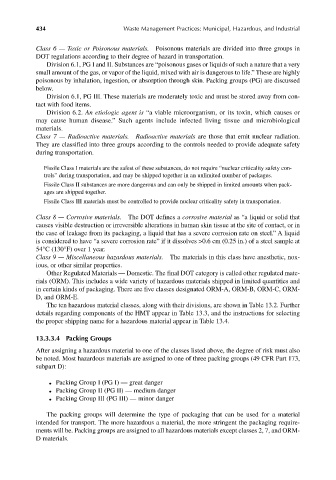Page 463 - Materials Chemistry, Second Edition
P. 463
CAT3525_C13.qxd 1/27/2005 12:30 PM Page 434
434 Waste Management Practices: Municipal, Hazardous, and Industrial
Class 6 — Toxic or Poisonous materials. Poisonous materials are divided into three groups in
DOT regulations according to their degree of hazard in transportation.
Division 6.1, PG I and II. Substances are “poisonous gases or liquids of such a nature that a very
small amount of the gas, or vapor of the liquid, mixed with air is dangerous to life.” These are highly
poisonous by inhalation, ingestion, or absorption through skin. Packing groups (PG) are discussed
below.
Division 6.1, PG III. These materials are moderately toxic and must be stored away from con-
tact with food items.
Division 6.2. An etiologic agent is “a viable microorganism, or its toxin, which causes or
may cause human disease.” Such agents include infected living tissue and microbiological
materials.
Class 7 — Radioactive materials. Radioactive materials are those that emit nuclear radiation.
They are classified into three groups according to the controls needed to provide adequate safety
during transportation.
Fissile Class I materials are the safest of these substances, do not require “nuclear criticality safety con-
trols” during transportation, and may be shipped together in an unlimited number of packages.
Fissile Class II substances are more dangerous and can only be shipped in limited amounts when pack-
ages are shipped together.
Fissile Class III materials must be controlled to provide nuclear criticality safety in transportation.
Class 8 — Corrosive materials. The DOT defines a corrosive material as “a liquid or solid that
causes visible destruction or irreversible alterations in human skin tissue at the site of contact, or in
the case of leakage from its packaging, a liquid that has a severe corrosion rate on steel.” A liquid
is considered to have “a severe corrosion rate” if it dissolves >0.6 cm (0.25 in.) of a steel sample at
54°C (130°F) over 1 year.
Class 9 — Miscellaneous hazardous materials. The materials in this class have anesthetic, nox-
ious, or other similar properties.
Other Regulated Materials — Domestic. The final DOT category is called other regulated mate-
rials (ORM). This includes a wide variety of hazardous materials shipped in limited quantities and
in certain kinds of packaging. There are five classes designated ORM-A, ORM-B, ORM-C, ORM-
D, and ORM-E.
The ten hazardous material classes, along with their divisions, are shown in Table 13.2. Further
details regarding components of the HMT appear in Table 13.3, and the instructions for selecting
the proper shipping name for a hazardous material appear in Table 13.4.
13.3.3.4 Packing Groups
After assigning a hazardous material to one of the classes listed above, the degree of risk must also
be noted. Most hazardous materials are assigned to one of three packing groups (49 CFR Part 173,
subpart D):
● Packing Group I (PG I) — great danger
● Packing Group II (PG II) — medium danger
● Packing Group III (PG III) — minor danger
The packing groups will determine the type of packaging that can be used for a material
intended for transport. The more hazardous a material, the more stringent the packaging require-
ments will be. Packing groups are assigned to all hazardous materials except classes 2, 7, and ORM-
D materials.

